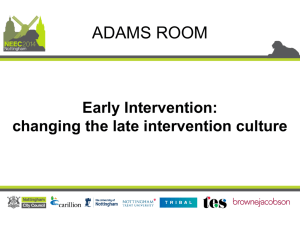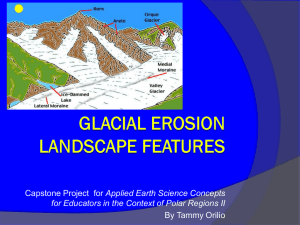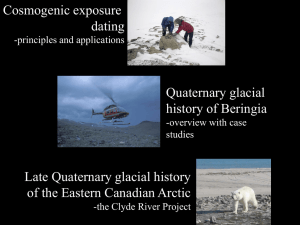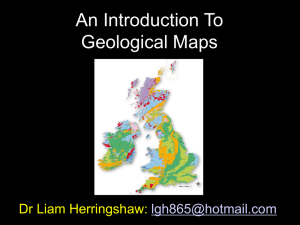Power Point Slides
advertisement
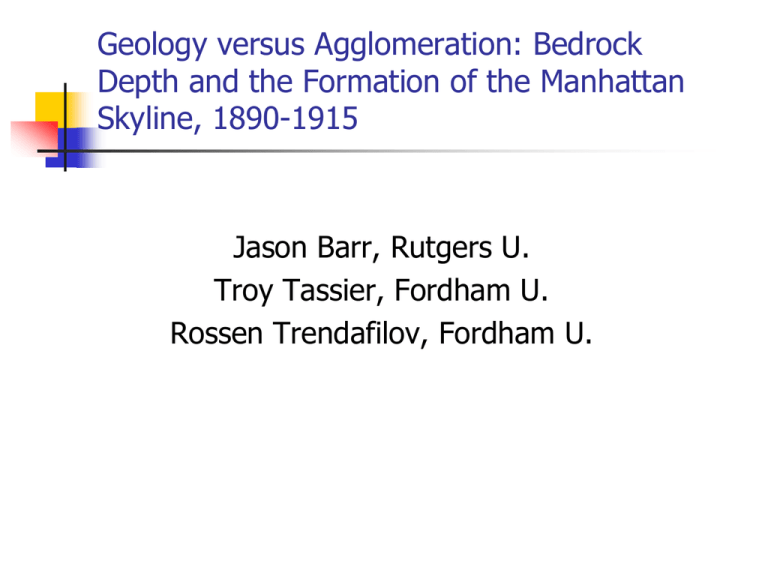
Geology versus Agglomeration: Bedrock Depth and the Formation of the Manhattan Skyline, 1890-1915 Jason Barr, Rutgers U. Troy Tassier, Fordham U. Rossen Trendafilov, Fordham U. Outline of Talk The “Debate”: Geology and the Spatial Distribution of Activity Summary of Conclusions Manhattan: Skyscrapers: 1890-1915 Geology and geography The “Great Leap” Results Costs Location Choices Some evidence on workers residence locations Extras (if time) Pictures Some Geological History The Skyline Why do we observe two clusters of skyscrapers in Manhattan and not one continuous one? Why did builders “jump” from downtown to midtown? What role did bedrock play in the location of skyscrapers? How sensitive were building decisions to changes in bedrock depths? Causation or Correlation? “[N]ear New York University, the surface bedrock drops appreciably—up to several hundred feet below the street level. Farther south…it comes again to within about one hundred feet of the surface. Dividing Manhattan into the ‘downtown’ and ‘midtown’ districts….That is to say, the skyscrapers of New York City are clustered together into the midtown group, where the bedrock is within several feet of the surface, and the downtown group, where the bedrock again reappears to within forty feet of the surface near Wall Street. In any event, it is readily seen how clearly the accessibility of the bedrock has, to some degree, controlled the architectural planning of the city.” From The Geology of New York City and Environs, C. J. Schuberth © 1968, pps. 8182. Emphasis added by me. Conclusions Depth to bedrock appears to have had, at best, a modest effect on the distribution of skyscrapers. Some evidence of bedrock effect within downtown. Jump was driven by: Transportation hubs. Avoidance of dense residential and manufacturing districts. Readjustment to be near white collar workers. Manhattan Geology Manhattan Skyscrapers and Nonskyscrapers (1915) Skyscraper Technology Here skyscraper: 80 meters or taller (about 20 stories). First NYC skyscraper 1889: 11 stories. Pulitzer World Building (1890), 20 stories, 94 meters. Steel skeleton. Elevator with safety break. Caissons to anchor building to bedrock. Skyscrapers and Bedrock After a certain height, a building had to be anchored to bedrock so as to prevent (possible uneven) settling. If two buildings have the same total area, but one had three stories and the second had 20 stories, only the second building would need to be anchored. Skyscrapers Statistics, 1890-1915 Depth to Bedrock (1915) nonskyscrapers skyscrapers Depth to Bedrock (Meters) 50 North 100 feet 40 14th St. 30 Bow ling 42nd St. Green Central Park South 20 Canal St. 10 City Hall 0 40.70 40.71 40.72 40.73 40.74 40.75 40.76 Latitude (Degrees) 40.77 Building Heights and Bedrock Depths Relative to Street Level Avg. Relative Building Height Avg. Relative Bedrock Depth 80% =>=>=North=>=> 50% 20% -10%40.706 40.708 40.711 40.715 40.719 40.725 40.732 40.739 40.744 40.752 40.755 -40% Latitude (Degrees) -70% “100 feet” -100% 40.763 The “Great Leap”: Location of Skyscrapers over Time Latitude (degrees) 40.77 40.76 40.75 40.74 40.73 40.72 40.71 40.70 1890 1895 1900 1905 1910 Year 1915 Population Movement: Manhattan Residents above 40th Street Pop %Pop 1,400,000 60% 1,200,000 50% 1,000,000 40% 800,000 30% 600,000 20% 400,000 10% 200,000 0% 0 1860 1870 1880 1890 1900 1910 Demographic Locations, 1890 % White with two native parents % Foreign Bedrock depth 65 45 25 5 40.7 -15 -35 -55 40.71 40.72 40.73 40.74 40.75 40.76 40.77 The El’s (1890): # El’s w/in ½ mile radius of each lot 14 City Hall 12 14th St 10 42nd St 8 6 4 2 0 40.705 40.715 40.725 40.735 40.745 40.755 40.765 Model Description Office-based firms have a demand for height, where height (space) is input into production. Demand is function of agglomeration benefits and office rent. Developers supply height based on office rents and cost of construction Equilibrium height is function of agglomeration effects and cost of anchoring to bedrock. h h A j , c j * Pr(h h | x) Gxβ * Example: Agglom. Benefits Large, Bedrock Costs Larger Building height Bedrock not relevant, as agglom. benefits fade away Building height Bedrock a barrier hbar hbar Distance from Center Distance from Center Construction Cost Data Fuller Construction Company 53 large commercial projects in Manhattan, 1899-1915 Data Collected: Total Construction Costs Depth to Bedrock Building Height Building Volume Index of Brick Costs Construction Costs Descriptive Stats. Regression Results Cost Effects Bedrock costs not relevant (even negative) for smaller projects. For larger projects, only a small fraction of total building costs. Differences in land prices between the financial district and the bedrock valley were several hundred thousand dollars. A skyscraper could have been built more cheaply in the bedrock valley than in the financial district when you consider the net effect of additional bedrock costs and land acquisition costs. Cost Effects For median skyscraper (21 stories), additional meter down increases costs by about $650 per meter. A 1 st. dev. change in depth to bedrock from the average adds about ½%. Largest skyscraper (32 stories) increases construction costs by about $9,000 for each 1 meter increase in the bedrock depth (7%). Spatial Distribution: Data Skyscrapers: skyscraperpage.com & emporis.com Non-skyscrapers: randomly chosen lots. Heights checked against 1921 Land Book for Manhattan. Bedrock: (1) Boring maps, (2) USGS contour maps. Population and Worker Density: Federal and State Censuses. Land Values and Assessed Values: Reports from the Tax Commissioners of NYC. Elevated Trains: El Maps from 1890. Demographics: 1890 Census. Sanitation Districts, 1890 Spatial Distribution: Data & Descriptive Statistics 1 hectare = 2.5 acres Probit Results: Marginal effects on prob. of skyscraper on given plot of land Predicted Probability of Skyscraper holding bedrock constant 1.0 0.8 0.6 0.4 0.2 0.0 40.700 40.710 40.720 40.730 40.740 40.750 40.760 Latitude (degrees) 40.770 Difference in Predicted Probabilities with and without Bedrock Variable vs. Latitude (Pred P with BR - Pred P w/o BR) 0.15 0.10 0.05 0.00 40.71 -0.05 40.71 40.71 40.72 40.73 40.74 40.74 40.75 40.76 latitude (degrees) -0.10 -0.15 Latitude (degrees) Trow’s NYC Directory, 1892 Collected data on job and home address for 5000 workers. 4878 were living in Manhattan. Created job categories (in part based on 1890 census). Trow’s NYC Directory, 1892 Job Category Manufacturing Domestic service Transportation Clerk Sales Professional service Protection FIRE Agents and Collectors Peddlers Managers and Foreman Total Freq. 1,724 667 582 577 503 354 154 98 87 80 52 4,878 Percent 35.3 13.7 11.9 11.8 10.3 7.3 3.2 2.0 1.8 1.6 1.1 100 Trow’s NYC Directory, 1892 Top 10 Jobs Rank 1 2 3 4 5 6 7 8 9 10 Job Freq. Clerk 577 Laborer 361 Tailor 254 Driver 226 Carpenter 167 Painter 122 Engineer 108 Lawyer 90 Cutter 88 Smith 87 Percent 11.8 7.4 5.2 4.6 3.4 2.5 2.2 1.9 1.8 1.8 Distribution of Sample Location of skyscrapers 1890-1915 Location of workers in Finance, Insurance and Real Estate (FIRE) !( !( !( !( (! !( !( !( !( !( (!!( (! !( !( !( !( (! !( !( !( !( (!!( (! !( !( (! !( !( !( !( !( !( !( !( !( !(!(!( !( !( !(!(!( !( !( ( ! !( !( !( !( !( !( !(!(!(!( !( !( !( !( !( !( !( !( !(!( !( !( !(!( !( !(!( !( !( !( (!!( !( !( !( !( !( !( !( !( !( !( (!!( !( Location of FIRE and Professional Workers !( !( !( !( (! !( !( !( !( !( (!!( (! !( !( !( !( (! !( !( !( !( (!!( (! !( !( (! !( !( !( !( !( !( !( !( !( !(!(!( !( !( !(!(!( !( !( ( ! !( !( !( !( !( !( !(!(!(!( !( !( !( !( !( !( !( !( !(!( !( !( !(!( !( !(!( !( !( !( (!!( !( !( !( !( !( !( !( !( !( !( (!!( !( !( !( Laborers (green), FIRE (yellow), Professional (blue) !( !( !( !( (! !( (! !( !( !( !( !(!( !( !( !(!(!(!( !( !( !( !( !( !(!( !(!( !( !( !(!(!( !( !( !(!( !( !( !(!( !( !(!( !( !(!( !( !( !(!(!( !( !( !( !( !( !( !( !( !( !( !(!(!( !( !( !( !( ( ! ( ! !(!(!( !( !( !( !( !( !(!( !( !( !( !( !( !(!( !(!(!( !( !( !( !( !( !(!( !(!( ( ! !(!( !( !( !( !( !( !( !( !( !(!( !( !( !( ( ! !( !( !(!( !(!( !(!( ( ! ( ! !( !( !( !( !( !(!( !(!(!(!( !(!( !( !(!( !( !( !( !(!( !(!(!( !(!(!(!(!( !( !(!( !( !( !( !( !(!(!( !(!(!( !(!(!( !( !(!(!(!(!( !(!( !( !(!( ( ! ( ! ( ! !(!(!(!( !( !(!( !(!( !( !( !( !( !( !(!(!(!(!( !(!(!( !(!( !(!( !(!( !(!(!(!(!(!(!( !(!( ( ! ( ! ( ! ( ! !(!( !(!( !(!(!( !(!( !( !( !( !( !( !( !( !( !(!( !( !( !( !( !( !( !( !(!( !(!(!( !(!( !(!(!(!( !( !( !( !( !( !(!(!( !(!(!(!(!( !( !(!(!(!(!(!(!( !(!(!(!( !(!( !(!( !( !( !( !( !( !( !( !( !(!( !( !( !(!(!(!( !(!( !( !( !(!(!( !( !( !( !( !( !( !( !(!( !(!(!(!( !(!(!(!(!(!( !(!( !( !( !(!(!( !(!(!(!(!(!(!(!( !( !(!( !( !(!( !(!(!(!(!(!( !( !(!( !( !(!( !( !( !( !(!(!( !(!(!( !( !( !( !(!( !(!( !(!(!( !(!( !( !(!(!(!(!( !( ( ! !( !(!(!(!(!( !( !( !( !(!(!(!( !( !( !(!( !(!( !( !( !(!(!( !( !( !( !(!(!( !( !( !(!(!( !( !( !(!( !( !(!(!(!( !( !( !(!( !( !(!( !( !( !(!( !( !( !(!(!( !(!(!(!(!(!(!(!( !(!(!(!(!( !(!(!(!(!( !(!(!(!( !(!(!(!(!(!(!( !(!(!(!( !( !(!( !(!( !( !( !( !( !(!(!( !( !( !( !( !(!( !( !( !( !( !(!(!(!( !( !(!( !(!( !( !(!( !( !( !(!(!( !( !( !(!(!( !( !( !(!( !( !( !( !( !(!( !( ( ! !( !( !( !(!(!(!( !( !( !( !(!( !( ( ! ( ! !(!( !( !( !( ( ! ( ! !(!( !(!( !(!( !( !( !( !( !( !(!( !(!( !( !( !( !( !( !(!(!(!( !( !( !( !(!( !( !(!( !(!(!(!(!(!( !( !( !( !( !( !( !( !( !( !(!( !( !(!( !( !( !( !( !( !(!( !(!( !( !(!(!( !( !( !(!(!( !(!( !( !( !( !( !(!( !( !( !( ( ! !( !( !( !( !(!( !( !( !( !(!( !(!( !( !(!(!(!(!( !( !( ^ ^ ^ ^ ^ ^^ ^^ ^ ^^^^ ^ ^^^ ^^^ ^^ ^^^ ^ ^^ ^^^^^ ^^^ ^^ ^ ^^ ^ ^ ^ ^ ^^ ^^ ^ ^ ^ ^^^^^ ^^ ^^^ ^^ ^^^^ ^ ^^ ^^^ ^^ ^^^^ ^ ^^^^^^^^^^ ^^^^^ ^ ^ ^ ^ ^ ^ ^ ^ ^^ ^^^^^^ ^^^ ^ ^^^ ^^^^^ ^ ^^ ^^^^^ ^^^^^ ^^^^^^^^^^^^^^^^^^ ^^^ ^^^^ ^ ^ ^ ^ ^ ^ ^ ^ ^ ^^ ^^^^^^^^ ^ ^^^^^^^^^^^^^^^^^^ ^^ ^ ^ ^^^ ^ ^ ^^^^^^ ^^^^ ^ ^^^ ^ ^ ^ ^^ ^^^^ ^ ^ ^^^^^^^^^^^^^^^^^^^^^^ ^^^^^^^^^^^^^^^^ ^ ^ ^^^ ^ ^^ ^^^ ^^^^^^^^^^^^^^^^^^^^^^^^^^^^^^^^ ^ ^^^^^^^^^ ^^^^^^^^^^^^^ ^ ^ ^ ^ ^ ^^^^^^^^^^^ ^^^^^ ^^ ^ ^^^^^^^^^^^^^ ^^^^^^^^^^^^^^^^^^^^^^^^^^ ^ ^ ^ ^ ^^^^^^ ^^ ^ ^^^^^^^ ^^^^^^^^^^^^^^^^ ^^^^ ^ ^ ^^ ^^^^^^^^^^^^^^^^^^^^^^ ^ ^^ ^^^^^^^^^^^^^ ^ ^^^^^^ ^^^^^^^^^^^^^^^^^^^^ ^^^ ^ ^ ^^ ^^^^^^ ^^^^^ ^^^^ ^ ^^^^^^^^ ^^^^^^^^^^^^^^^^^^^^ ^ ^ ^ ^^^^^^^^^^^^^ ^ ^ ^^^^ ^^^^^^ ^^^ ^ ^ ^^^^^^^^ ^^^ ^^^^^^ ^ ^ ^^ ^^ ^^^^^^^^^^^^^^^^ ^^^^^ ^^ ^ ^ ^^^^^^^^^^^^^^ ^ ^^ ^^ ^ ^^^^^^^ ^^^^^ ^ ^ ^^^^^^^^^^^^^ ^ ^^^ ^ ^^^^^^^ ^ ^^ ^^^ ^ ^^^ ^^^^^^^ ^ ^ ^^^^ ^^^ ^^^^^^^^^ ^ ^^^^^^^^^^^^^^^^^^^ ^^^^ ^ ^ ^ ^ ^ ^ ^^^^^^^^ ^^^^^^^^ ^ ^^^^^^^^^^^^^^^^^^^^^^^^^^^^^^^^^ ^ ^^^^ ^ ^^^^^^^^^^ ^^ ^ ^ ^ ^^^^^^^^^^^^^^^^^^^^^^^^^^^^^^^^^^^^^^^^^^^^^^^^^^^ ^^^ ^^ ^^ ^^^^^^^^^^^^^^^^^^^^^^^^^ ^^ ^^ ^^^^^^^^^^^^^^^^ ^^^^^^^^^^^^^^^^^^^^^^ ^^^^^^^^^ ^^ ^ ^^^^ ^ ^ ^ ^ ^^ Workers in Manufacturing Jobs Conclusions Regarding Bedrock Effect H1: Insurmountable barrier after some depth. Refuted by scatter plot. H2: Economically not viable after some point Refuted by cost regressions. H3: Tipping Point Effect Refuted by predicted skyline based on holding bedrock constant. H4: Little or No Effect. Consistent with regressions and predicted skyline. Conclusions Readjustment to new spatial equilibrium: “Edge City” formation. Population Movement. Factory and Slum “flight.” Transportation Hubs. Other Economic Factors. Appendix I: Pictures Tribune Building (1875) “The brick piers of the exterior walls had to be enormously thick in the lower part of the building to bear the weight of the stories above.” (Landau and Condit) “The nine-story height insured that the tower would be taller than any existing New York office building and was thus neither an arbitrary choice of height nor one based on the functional space requirements of the newspaper. The design of the Tribune building was primarily governed by the enhanced public image that would be garnered for the newspaper and only tangentially by the potential economic benefits of building tall” (Wallace 2006) Home Insurance Building (1885), Chicago 10 stories of 138 feet (42 m) The Tower Building (1889): New York’s first “skyscraper” 11 Stories Ego or Economics? Cass Gilbert: The skyscraper “is a machine that makes the land pay” (ER, 1900). F.W. Woolworth: “I do not want a mere building, I want something that will be an ornament to the city'' (NY Times, 1910). Pulitzer’s World Building, 1890 20 stories, 94 meters The Flatiron (1902), 22, 87 meters NY Times Building (1904) 25, stories, 111 meters Woolworth Building (1913) 57 stories, 241 meters. Equitable Building (1915) 40 Stories, 164 meters Appendix II: Geological History 500 MYA: NYC bedrock began as muds and sands deposited in the Iapetus Ocean (off coast of what is now N. Am.). Due to compaction they became sedimentary rocks. 440 MYA: Plate tectonics closed this ocean; massive island chain collided into N. Am. Geological History Cont. Sedimentary rocks became folded and deformed and were buried deep within a mountain range called the Taconic Mountains (akin to Himalayas). Mountain range weight metamorphized sedimentary rock to schist and gneiss. Erosion has worn these mountains away leaving current bedrock. The Last Ice Age During the Pleistocene epoch (the Ice Age: about 1.8 million years ago to 8,000 years ago), large ice sheets bulldozed the landscape. Rocks within the glaciers scraped and scratched the bedrock of Central Park producing long linear striations and grooves. Long Island is composed of rubble that the glacier left behind as it melted. http://research.amnh.org/eps/nycgeology
